Sociology 9: Developing a Multicultural Environment Plan for Schools
VerifiedAdded on 2022/08/20
|11
|2737
|32
Essay
AI Summary
This essay outlines a plan for developing a multicultural environment in a school setting, emphasizing the importance of teacher training, community collaboration, and the inclusion of diverse cultural elements within the classroom. It discusses key strategies such as implementing bilingual programs, encouraging critical thinking, preventing prejudicial thoughts, and fostering family and community participation to support multilingual development in children. The plan includes methods for language testing and assessment, structuring lessons to accommodate diverse learning styles, and revising school policies to promote intercultural understanding. It further addresses potential barriers to multicultural education and proposes contingency plans to overcome these challenges, highlighting the crucial role of teachers in creating a safe, inclusive, and culturally responsive learning environment.
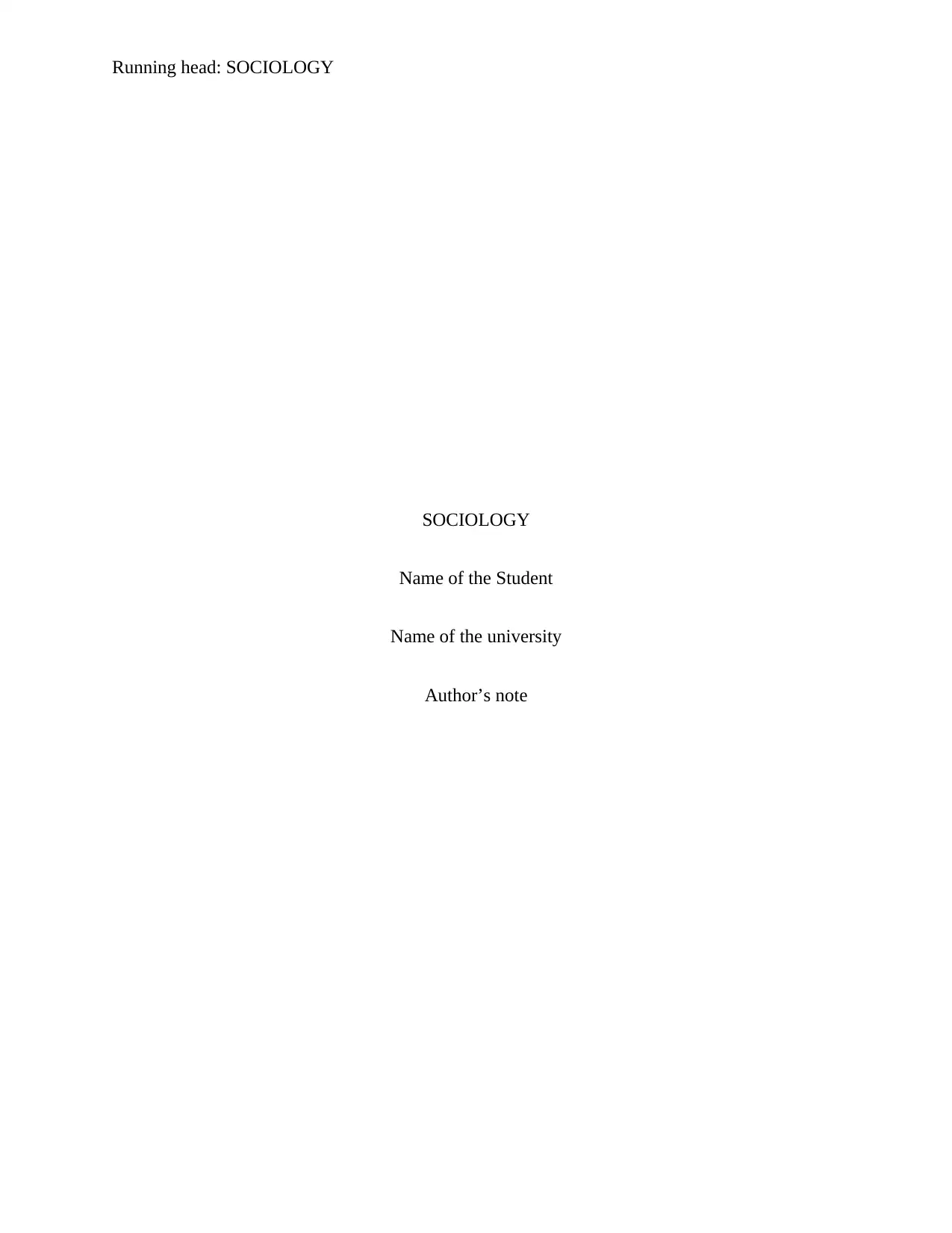
Running head: SOCIOLOGY
SOCIOLOGY
Name of the Student
Name of the university
Author’s note
SOCIOLOGY
Name of the Student
Name of the university
Author’s note
Paraphrase This Document
Need a fresh take? Get an instant paraphrase of this document with our AI Paraphraser
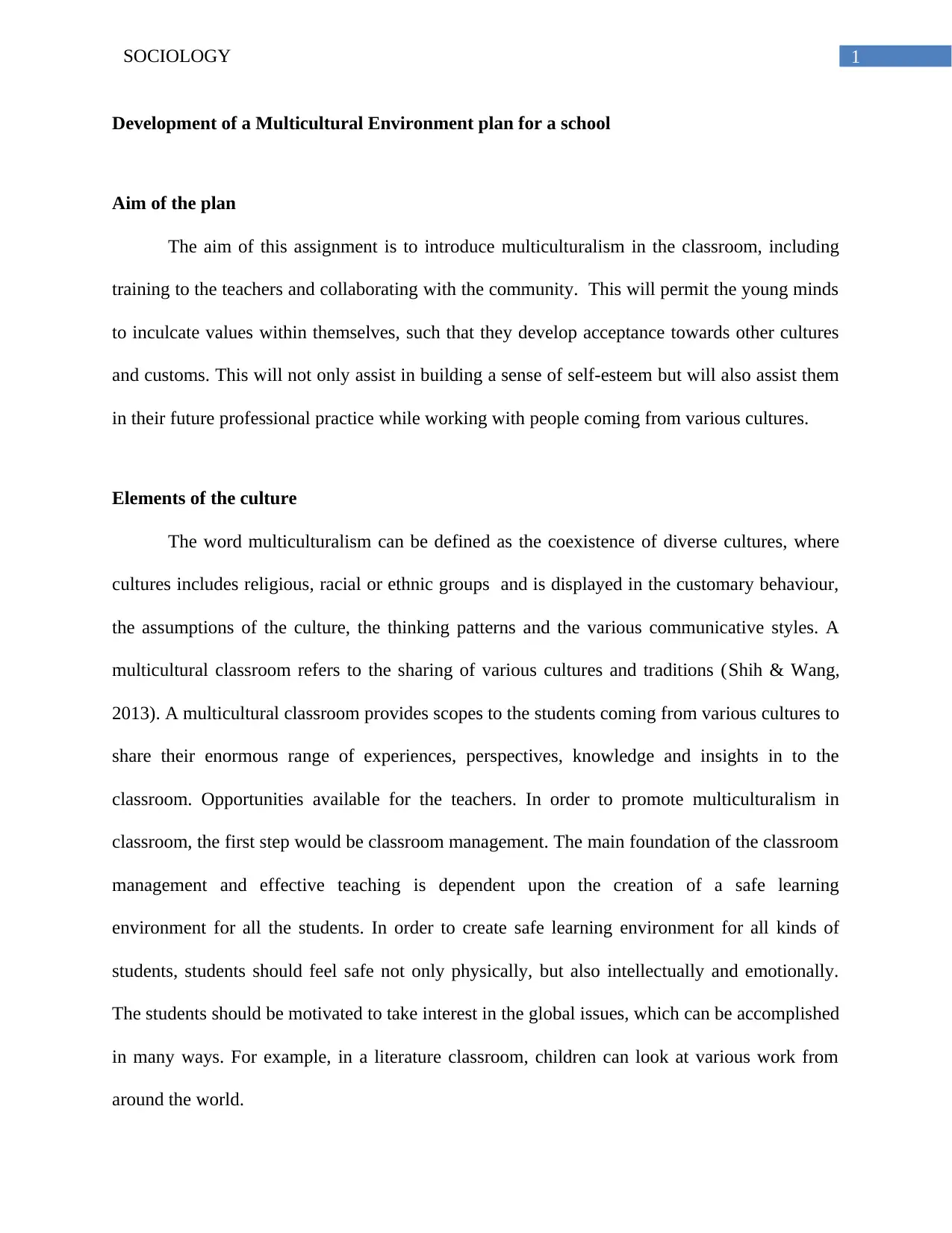
1SOCIOLOGY
Development of a Multicultural Environment plan for a school
Aim of the plan
The aim of this assignment is to introduce multiculturalism in the classroom, including
training to the teachers and collaborating with the community. This will permit the young minds
to inculcate values within themselves, such that they develop acceptance towards other cultures
and customs. This will not only assist in building a sense of self-esteem but will also assist them
in their future professional practice while working with people coming from various cultures.
Elements of the culture
The word multiculturalism can be defined as the coexistence of diverse cultures, where
cultures includes religious, racial or ethnic groups and is displayed in the customary behaviour,
the assumptions of the culture, the thinking patterns and the various communicative styles. A
multicultural classroom refers to the sharing of various cultures and traditions (Shih & Wang,
2013). A multicultural classroom provides scopes to the students coming from various cultures to
share their enormous range of experiences, perspectives, knowledge and insights in to the
classroom. Opportunities available for the teachers. In order to promote multiculturalism in
classroom, the first step would be classroom management. The main foundation of the classroom
management and effective teaching is dependent upon the creation of a safe learning
environment for all the students. In order to create safe learning environment for all kinds of
students, students should feel safe not only physically, but also intellectually and emotionally.
The students should be motivated to take interest in the global issues, which can be accomplished
in many ways. For example, in a literature classroom, children can look at various work from
around the world.
Development of a Multicultural Environment plan for a school
Aim of the plan
The aim of this assignment is to introduce multiculturalism in the classroom, including
training to the teachers and collaborating with the community. This will permit the young minds
to inculcate values within themselves, such that they develop acceptance towards other cultures
and customs. This will not only assist in building a sense of self-esteem but will also assist them
in their future professional practice while working with people coming from various cultures.
Elements of the culture
The word multiculturalism can be defined as the coexistence of diverse cultures, where
cultures includes religious, racial or ethnic groups and is displayed in the customary behaviour,
the assumptions of the culture, the thinking patterns and the various communicative styles. A
multicultural classroom refers to the sharing of various cultures and traditions (Shih & Wang,
2013). A multicultural classroom provides scopes to the students coming from various cultures to
share their enormous range of experiences, perspectives, knowledge and insights in to the
classroom. Opportunities available for the teachers. In order to promote multiculturalism in
classroom, the first step would be classroom management. The main foundation of the classroom
management and effective teaching is dependent upon the creation of a safe learning
environment for all the students. In order to create safe learning environment for all kinds of
students, students should feel safe not only physically, but also intellectually and emotionally.
The students should be motivated to take interest in the global issues, which can be accomplished
in many ways. For example, in a literature classroom, children can look at various work from
around the world.
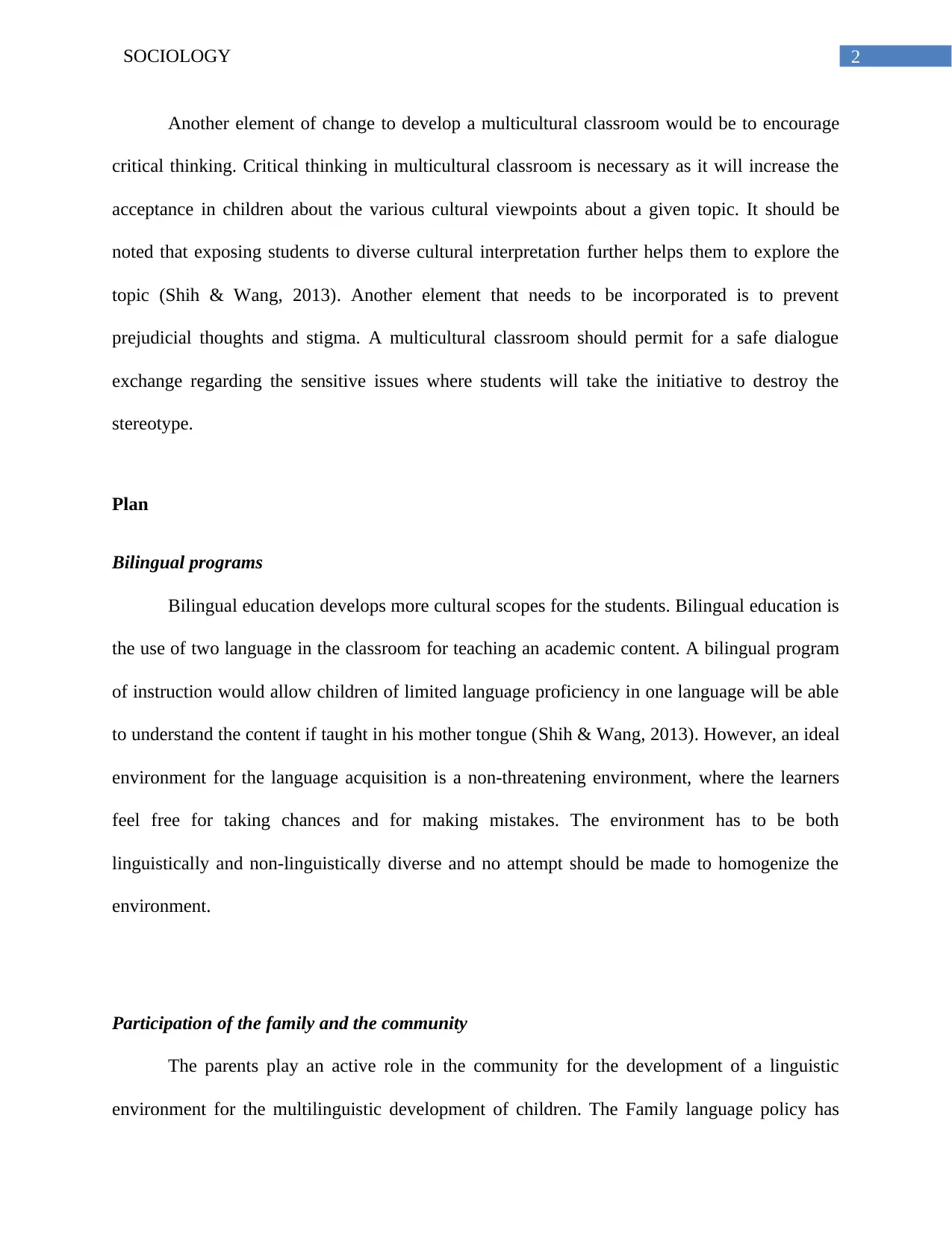
2SOCIOLOGY
Another element of change to develop a multicultural classroom would be to encourage
critical thinking. Critical thinking in multicultural classroom is necessary as it will increase the
acceptance in children about the various cultural viewpoints about a given topic. It should be
noted that exposing students to diverse cultural interpretation further helps them to explore the
topic (Shih & Wang, 2013). Another element that needs to be incorporated is to prevent
prejudicial thoughts and stigma. A multicultural classroom should permit for a safe dialogue
exchange regarding the sensitive issues where students will take the initiative to destroy the
stereotype.
Plan
Bilingual programs
Bilingual education develops more cultural scopes for the students. Bilingual education is
the use of two language in the classroom for teaching an academic content. A bilingual program
of instruction would allow children of limited language proficiency in one language will be able
to understand the content if taught in his mother tongue (Shih & Wang, 2013). However, an ideal
environment for the language acquisition is a non-threatening environment, where the learners
feel free for taking chances and for making mistakes. The environment has to be both
linguistically and non-linguistically diverse and no attempt should be made to homogenize the
environment.
Participation of the family and the community
The parents play an active role in the community for the development of a linguistic
environment for the multilinguistic development of children. The Family language policy has
Another element of change to develop a multicultural classroom would be to encourage
critical thinking. Critical thinking in multicultural classroom is necessary as it will increase the
acceptance in children about the various cultural viewpoints about a given topic. It should be
noted that exposing students to diverse cultural interpretation further helps them to explore the
topic (Shih & Wang, 2013). Another element that needs to be incorporated is to prevent
prejudicial thoughts and stigma. A multicultural classroom should permit for a safe dialogue
exchange regarding the sensitive issues where students will take the initiative to destroy the
stereotype.
Plan
Bilingual programs
Bilingual education develops more cultural scopes for the students. Bilingual education is
the use of two language in the classroom for teaching an academic content. A bilingual program
of instruction would allow children of limited language proficiency in one language will be able
to understand the content if taught in his mother tongue (Shih & Wang, 2013). However, an ideal
environment for the language acquisition is a non-threatening environment, where the learners
feel free for taking chances and for making mistakes. The environment has to be both
linguistically and non-linguistically diverse and no attempt should be made to homogenize the
environment.
Participation of the family and the community
The parents play an active role in the community for the development of a linguistic
environment for the multilinguistic development of children. The Family language policy has
⊘ This is a preview!⊘
Do you want full access?
Subscribe today to unlock all pages.

Trusted by 1+ million students worldwide
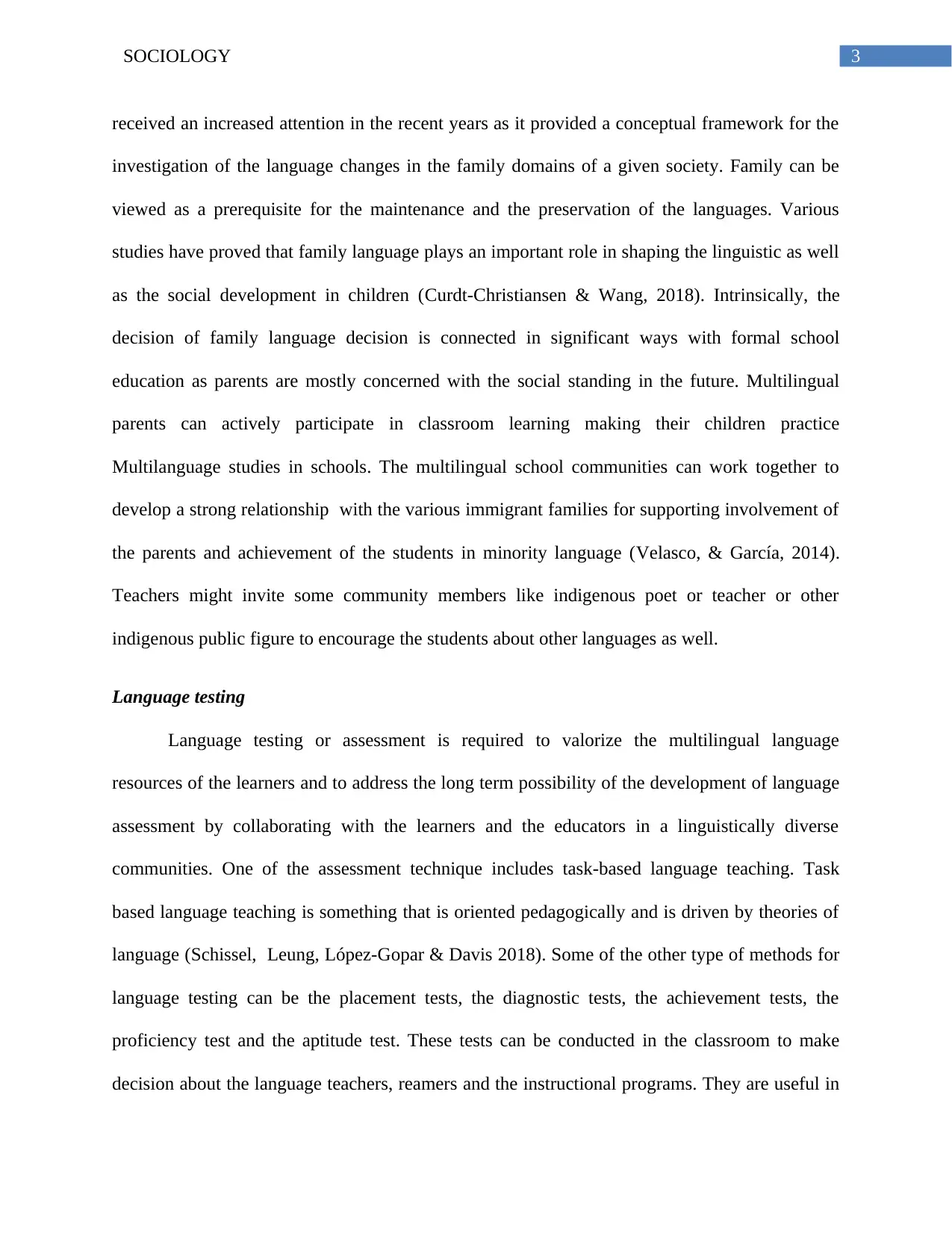
3SOCIOLOGY
received an increased attention in the recent years as it provided a conceptual framework for the
investigation of the language changes in the family domains of a given society. Family can be
viewed as a prerequisite for the maintenance and the preservation of the languages. Various
studies have proved that family language plays an important role in shaping the linguistic as well
as the social development in children (Curdt-Christiansen & Wang, 2018). Intrinsically, the
decision of family language decision is connected in significant ways with formal school
education as parents are mostly concerned with the social standing in the future. Multilingual
parents can actively participate in classroom learning making their children practice
Multilanguage studies in schools. The multilingual school communities can work together to
develop a strong relationship with the various immigrant families for supporting involvement of
the parents and achievement of the students in minority language (Velasco, & García, 2014).
Teachers might invite some community members like indigenous poet or teacher or other
indigenous public figure to encourage the students about other languages as well.
Language testing
Language testing or assessment is required to valorize the multilingual language
resources of the learners and to address the long term possibility of the development of language
assessment by collaborating with the learners and the educators in a linguistically diverse
communities. One of the assessment technique includes task-based language teaching. Task
based language teaching is something that is oriented pedagogically and is driven by theories of
language (Schissel, Leung, López-Gopar & Davis 2018). Some of the other type of methods for
language testing can be the placement tests, the diagnostic tests, the achievement tests, the
proficiency test and the aptitude test. These tests can be conducted in the classroom to make
decision about the language teachers, reamers and the instructional programs. They are useful in
received an increased attention in the recent years as it provided a conceptual framework for the
investigation of the language changes in the family domains of a given society. Family can be
viewed as a prerequisite for the maintenance and the preservation of the languages. Various
studies have proved that family language plays an important role in shaping the linguistic as well
as the social development in children (Curdt-Christiansen & Wang, 2018). Intrinsically, the
decision of family language decision is connected in significant ways with formal school
education as parents are mostly concerned with the social standing in the future. Multilingual
parents can actively participate in classroom learning making their children practice
Multilanguage studies in schools. The multilingual school communities can work together to
develop a strong relationship with the various immigrant families for supporting involvement of
the parents and achievement of the students in minority language (Velasco, & García, 2014).
Teachers might invite some community members like indigenous poet or teacher or other
indigenous public figure to encourage the students about other languages as well.
Language testing
Language testing or assessment is required to valorize the multilingual language
resources of the learners and to address the long term possibility of the development of language
assessment by collaborating with the learners and the educators in a linguistically diverse
communities. One of the assessment technique includes task-based language teaching. Task
based language teaching is something that is oriented pedagogically and is driven by theories of
language (Schissel, Leung, López-Gopar & Davis 2018). Some of the other type of methods for
language testing can be the placement tests, the diagnostic tests, the achievement tests, the
proficiency test and the aptitude test. These tests can be conducted in the classroom to make
decision about the language teachers, reamers and the instructional programs. They are useful in
Paraphrase This Document
Need a fresh take? Get an instant paraphrase of this document with our AI Paraphraser
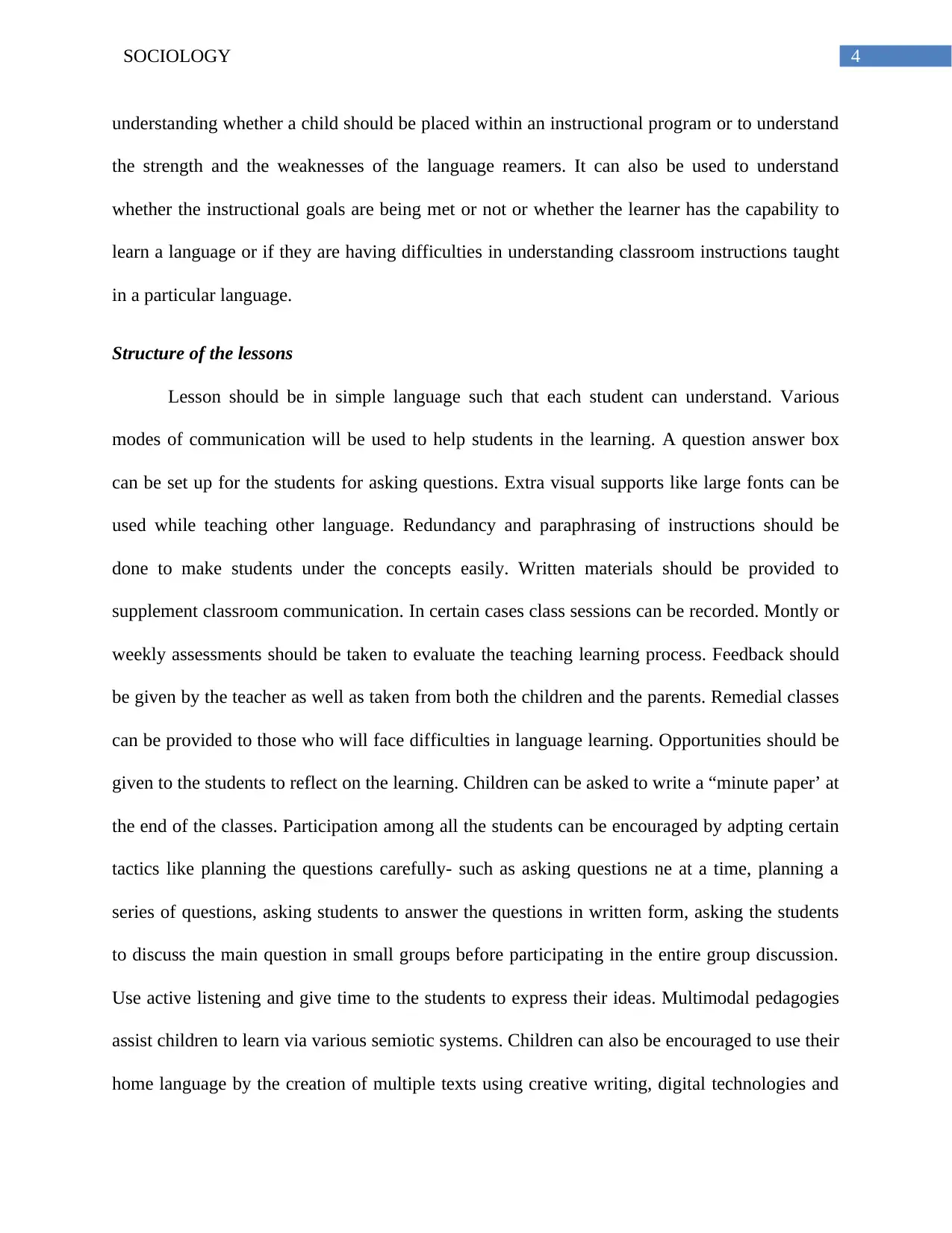
4SOCIOLOGY
understanding whether a child should be placed within an instructional program or to understand
the strength and the weaknesses of the language reamers. It can also be used to understand
whether the instructional goals are being met or not or whether the learner has the capability to
learn a language or if they are having difficulties in understanding classroom instructions taught
in a particular language.
Structure of the lessons
Lesson should be in simple language such that each student can understand. Various
modes of communication will be used to help students in the learning. A question answer box
can be set up for the students for asking questions. Extra visual supports like large fonts can be
used while teaching other language. Redundancy and paraphrasing of instructions should be
done to make students under the concepts easily. Written materials should be provided to
supplement classroom communication. In certain cases class sessions can be recorded. Montly or
weekly assessments should be taken to evaluate the teaching learning process. Feedback should
be given by the teacher as well as taken from both the children and the parents. Remedial classes
can be provided to those who will face difficulties in language learning. Opportunities should be
given to the students to reflect on the learning. Children can be asked to write a “minute paper’ at
the end of the classes. Participation among all the students can be encouraged by adpting certain
tactics like planning the questions carefully- such as asking questions ne at a time, planning a
series of questions, asking students to answer the questions in written form, asking the students
to discuss the main question in small groups before participating in the entire group discussion.
Use active listening and give time to the students to express their ideas. Multimodal pedagogies
assist children to learn via various semiotic systems. Children can also be encouraged to use their
home language by the creation of multiple texts using creative writing, digital technologies and
understanding whether a child should be placed within an instructional program or to understand
the strength and the weaknesses of the language reamers. It can also be used to understand
whether the instructional goals are being met or not or whether the learner has the capability to
learn a language or if they are having difficulties in understanding classroom instructions taught
in a particular language.
Structure of the lessons
Lesson should be in simple language such that each student can understand. Various
modes of communication will be used to help students in the learning. A question answer box
can be set up for the students for asking questions. Extra visual supports like large fonts can be
used while teaching other language. Redundancy and paraphrasing of instructions should be
done to make students under the concepts easily. Written materials should be provided to
supplement classroom communication. In certain cases class sessions can be recorded. Montly or
weekly assessments should be taken to evaluate the teaching learning process. Feedback should
be given by the teacher as well as taken from both the children and the parents. Remedial classes
can be provided to those who will face difficulties in language learning. Opportunities should be
given to the students to reflect on the learning. Children can be asked to write a “minute paper’ at
the end of the classes. Participation among all the students can be encouraged by adpting certain
tactics like planning the questions carefully- such as asking questions ne at a time, planning a
series of questions, asking students to answer the questions in written form, asking the students
to discuss the main question in small groups before participating in the entire group discussion.
Use active listening and give time to the students to express their ideas. Multimodal pedagogies
assist children to learn via various semiotic systems. Children can also be encouraged to use their
home language by the creation of multiple texts using creative writing, digital technologies and
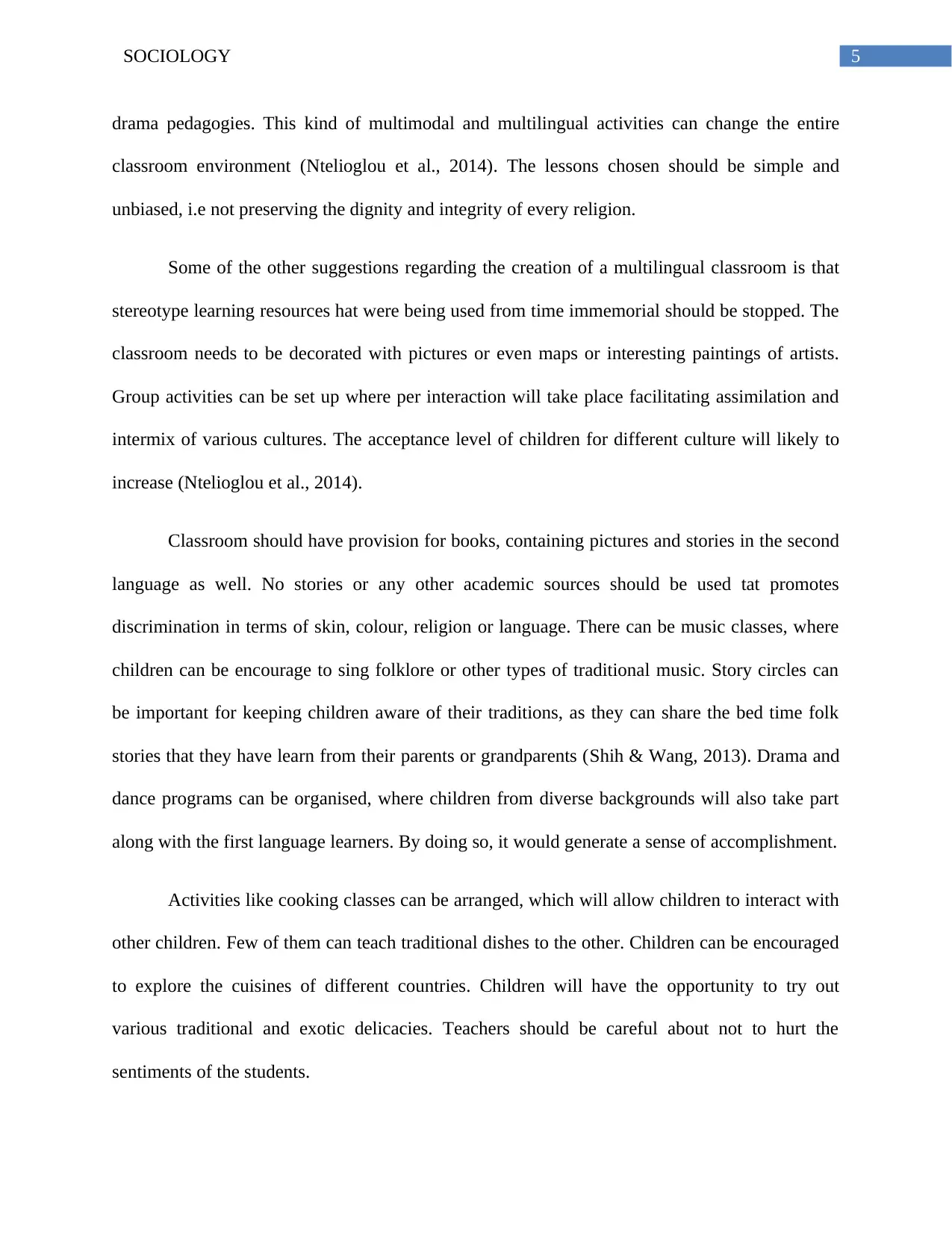
5SOCIOLOGY
drama pedagogies. This kind of multimodal and multilingual activities can change the entire
classroom environment (Ntelioglou et al., 2014). The lessons chosen should be simple and
unbiased, i.e not preserving the dignity and integrity of every religion.
Some of the other suggestions regarding the creation of a multilingual classroom is that
stereotype learning resources hat were being used from time immemorial should be stopped. The
classroom needs to be decorated with pictures or even maps or interesting paintings of artists.
Group activities can be set up where per interaction will take place facilitating assimilation and
intermix of various cultures. The acceptance level of children for different culture will likely to
increase (Ntelioglou et al., 2014).
Classroom should have provision for books, containing pictures and stories in the second
language as well. No stories or any other academic sources should be used tat promotes
discrimination in terms of skin, colour, religion or language. There can be music classes, where
children can be encourage to sing folklore or other types of traditional music. Story circles can
be important for keeping children aware of their traditions, as they can share the bed time folk
stories that they have learn from their parents or grandparents (Shih & Wang, 2013). Drama and
dance programs can be organised, where children from diverse backgrounds will also take part
along with the first language learners. By doing so, it would generate a sense of accomplishment.
Activities like cooking classes can be arranged, which will allow children to interact with
other children. Few of them can teach traditional dishes to the other. Children can be encouraged
to explore the cuisines of different countries. Children will have the opportunity to try out
various traditional and exotic delicacies. Teachers should be careful about not to hurt the
sentiments of the students.
drama pedagogies. This kind of multimodal and multilingual activities can change the entire
classroom environment (Ntelioglou et al., 2014). The lessons chosen should be simple and
unbiased, i.e not preserving the dignity and integrity of every religion.
Some of the other suggestions regarding the creation of a multilingual classroom is that
stereotype learning resources hat were being used from time immemorial should be stopped. The
classroom needs to be decorated with pictures or even maps or interesting paintings of artists.
Group activities can be set up where per interaction will take place facilitating assimilation and
intermix of various cultures. The acceptance level of children for different culture will likely to
increase (Ntelioglou et al., 2014).
Classroom should have provision for books, containing pictures and stories in the second
language as well. No stories or any other academic sources should be used tat promotes
discrimination in terms of skin, colour, religion or language. There can be music classes, where
children can be encourage to sing folklore or other types of traditional music. Story circles can
be important for keeping children aware of their traditions, as they can share the bed time folk
stories that they have learn from their parents or grandparents (Shih & Wang, 2013). Drama and
dance programs can be organised, where children from diverse backgrounds will also take part
along with the first language learners. By doing so, it would generate a sense of accomplishment.
Activities like cooking classes can be arranged, which will allow children to interact with
other children. Few of them can teach traditional dishes to the other. Children can be encouraged
to explore the cuisines of different countries. Children will have the opportunity to try out
various traditional and exotic delicacies. Teachers should be careful about not to hurt the
sentiments of the students.
⊘ This is a preview!⊘
Do you want full access?
Subscribe today to unlock all pages.

Trusted by 1+ million students worldwide
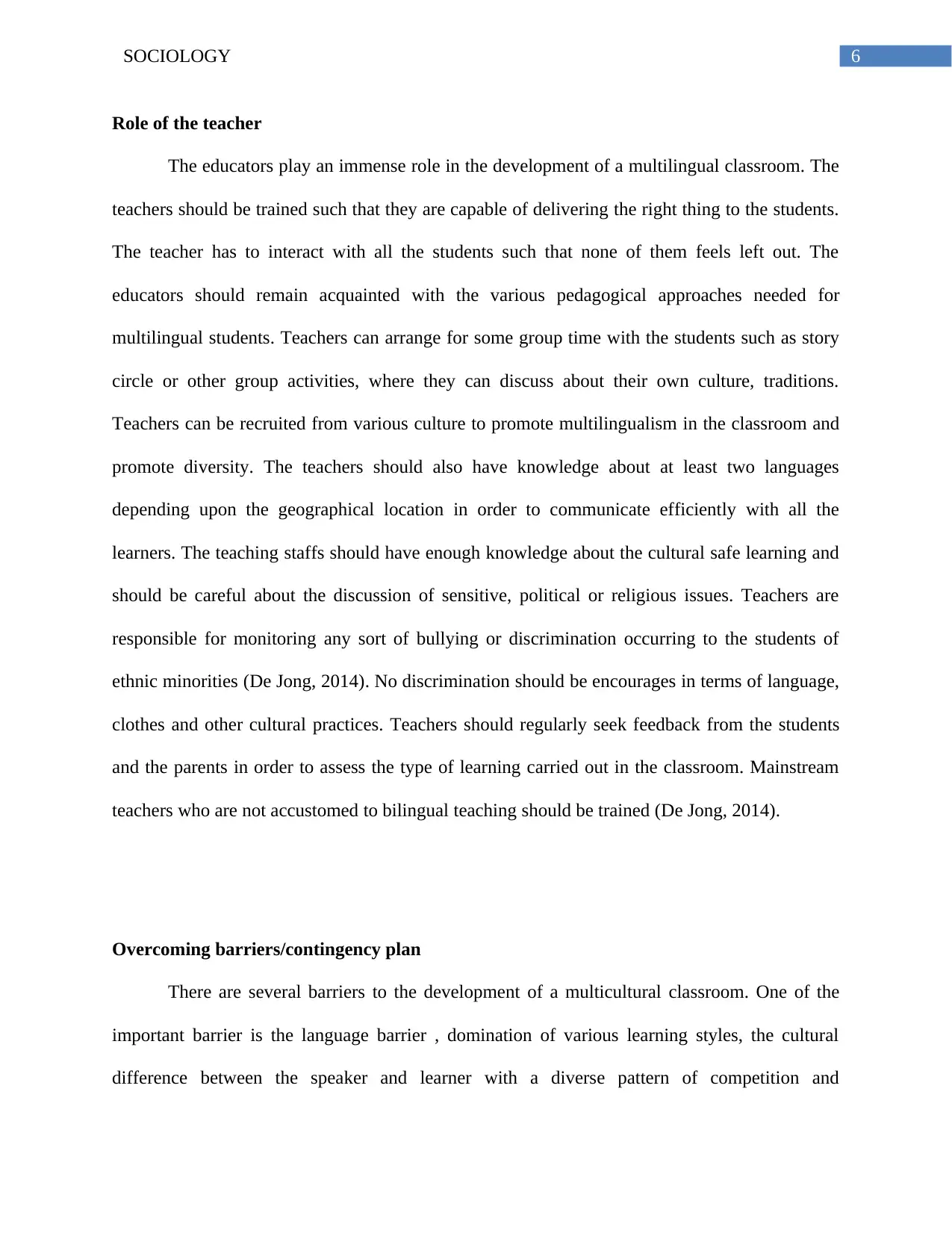
6SOCIOLOGY
Role of the teacher
The educators play an immense role in the development of a multilingual classroom. The
teachers should be trained such that they are capable of delivering the right thing to the students.
The teacher has to interact with all the students such that none of them feels left out. The
educators should remain acquainted with the various pedagogical approaches needed for
multilingual students. Teachers can arrange for some group time with the students such as story
circle or other group activities, where they can discuss about their own culture, traditions.
Teachers can be recruited from various culture to promote multilingualism in the classroom and
promote diversity. The teachers should also have knowledge about at least two languages
depending upon the geographical location in order to communicate efficiently with all the
learners. The teaching staffs should have enough knowledge about the cultural safe learning and
should be careful about the discussion of sensitive, political or religious issues. Teachers are
responsible for monitoring any sort of bullying or discrimination occurring to the students of
ethnic minorities (De Jong, 2014). No discrimination should be encourages in terms of language,
clothes and other cultural practices. Teachers should regularly seek feedback from the students
and the parents in order to assess the type of learning carried out in the classroom. Mainstream
teachers who are not accustomed to bilingual teaching should be trained (De Jong, 2014).
Overcoming barriers/contingency plan
There are several barriers to the development of a multicultural classroom. One of the
important barrier is the language barrier , domination of various learning styles, the cultural
difference between the speaker and learner with a diverse pattern of competition and
Role of the teacher
The educators play an immense role in the development of a multilingual classroom. The
teachers should be trained such that they are capable of delivering the right thing to the students.
The teacher has to interact with all the students such that none of them feels left out. The
educators should remain acquainted with the various pedagogical approaches needed for
multilingual students. Teachers can arrange for some group time with the students such as story
circle or other group activities, where they can discuss about their own culture, traditions.
Teachers can be recruited from various culture to promote multilingualism in the classroom and
promote diversity. The teachers should also have knowledge about at least two languages
depending upon the geographical location in order to communicate efficiently with all the
learners. The teaching staffs should have enough knowledge about the cultural safe learning and
should be careful about the discussion of sensitive, political or religious issues. Teachers are
responsible for monitoring any sort of bullying or discrimination occurring to the students of
ethnic minorities (De Jong, 2014). No discrimination should be encourages in terms of language,
clothes and other cultural practices. Teachers should regularly seek feedback from the students
and the parents in order to assess the type of learning carried out in the classroom. Mainstream
teachers who are not accustomed to bilingual teaching should be trained (De Jong, 2014).
Overcoming barriers/contingency plan
There are several barriers to the development of a multicultural classroom. One of the
important barrier is the language barrier , domination of various learning styles, the cultural
difference between the speaker and learner with a diverse pattern of competition and
Paraphrase This Document
Need a fresh take? Get an instant paraphrase of this document with our AI Paraphraser
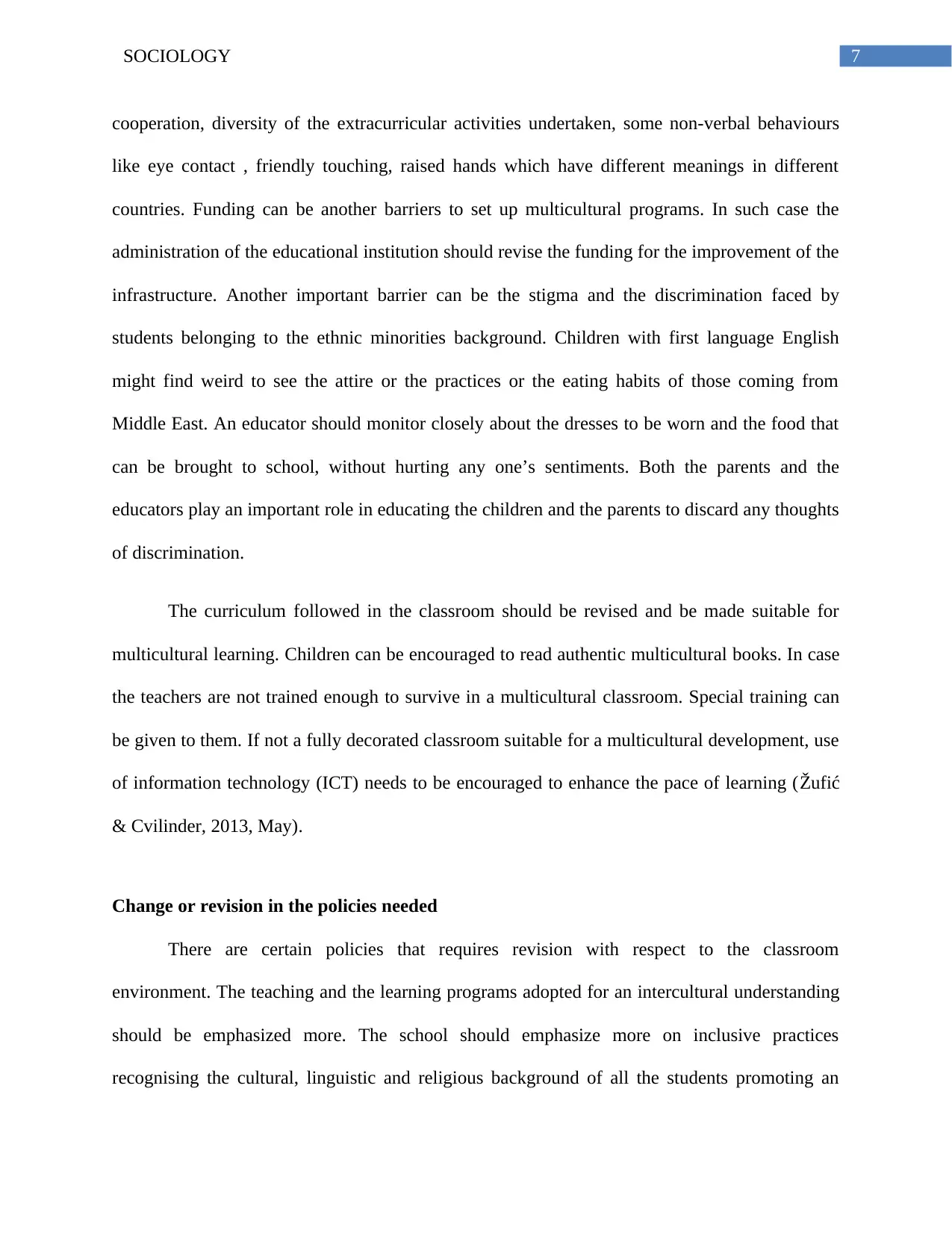
7SOCIOLOGY
cooperation, diversity of the extracurricular activities undertaken, some non-verbal behaviours
like eye contact , friendly touching, raised hands which have different meanings in different
countries. Funding can be another barriers to set up multicultural programs. In such case the
administration of the educational institution should revise the funding for the improvement of the
infrastructure. Another important barrier can be the stigma and the discrimination faced by
students belonging to the ethnic minorities background. Children with first language English
might find weird to see the attire or the practices or the eating habits of those coming from
Middle East. An educator should monitor closely about the dresses to be worn and the food that
can be brought to school, without hurting any one’s sentiments. Both the parents and the
educators play an important role in educating the children and the parents to discard any thoughts
of discrimination.
The curriculum followed in the classroom should be revised and be made suitable for
multicultural learning. Children can be encouraged to read authentic multicultural books. In case
the teachers are not trained enough to survive in a multicultural classroom. Special training can
be given to them. If not a fully decorated classroom suitable for a multicultural development, use
of information technology (ICT) needs to be encouraged to enhance the pace of learning (Žufić
& Cvilinder, 2013, May).
Change or revision in the policies needed
There are certain policies that requires revision with respect to the classroom
environment. The teaching and the learning programs adopted for an intercultural understanding
should be emphasized more. The school should emphasize more on inclusive practices
recognising the cultural, linguistic and religious background of all the students promoting an
cooperation, diversity of the extracurricular activities undertaken, some non-verbal behaviours
like eye contact , friendly touching, raised hands which have different meanings in different
countries. Funding can be another barriers to set up multicultural programs. In such case the
administration of the educational institution should revise the funding for the improvement of the
infrastructure. Another important barrier can be the stigma and the discrimination faced by
students belonging to the ethnic minorities background. Children with first language English
might find weird to see the attire or the practices or the eating habits of those coming from
Middle East. An educator should monitor closely about the dresses to be worn and the food that
can be brought to school, without hurting any one’s sentiments. Both the parents and the
educators play an important role in educating the children and the parents to discard any thoughts
of discrimination.
The curriculum followed in the classroom should be revised and be made suitable for
multicultural learning. Children can be encouraged to read authentic multicultural books. In case
the teachers are not trained enough to survive in a multicultural classroom. Special training can
be given to them. If not a fully decorated classroom suitable for a multicultural development, use
of information technology (ICT) needs to be encouraged to enhance the pace of learning (Žufić
& Cvilinder, 2013, May).
Change or revision in the policies needed
There are certain policies that requires revision with respect to the classroom
environment. The teaching and the learning programs adopted for an intercultural understanding
should be emphasized more. The school should emphasize more on inclusive practices
recognising the cultural, linguistic and religious background of all the students promoting an
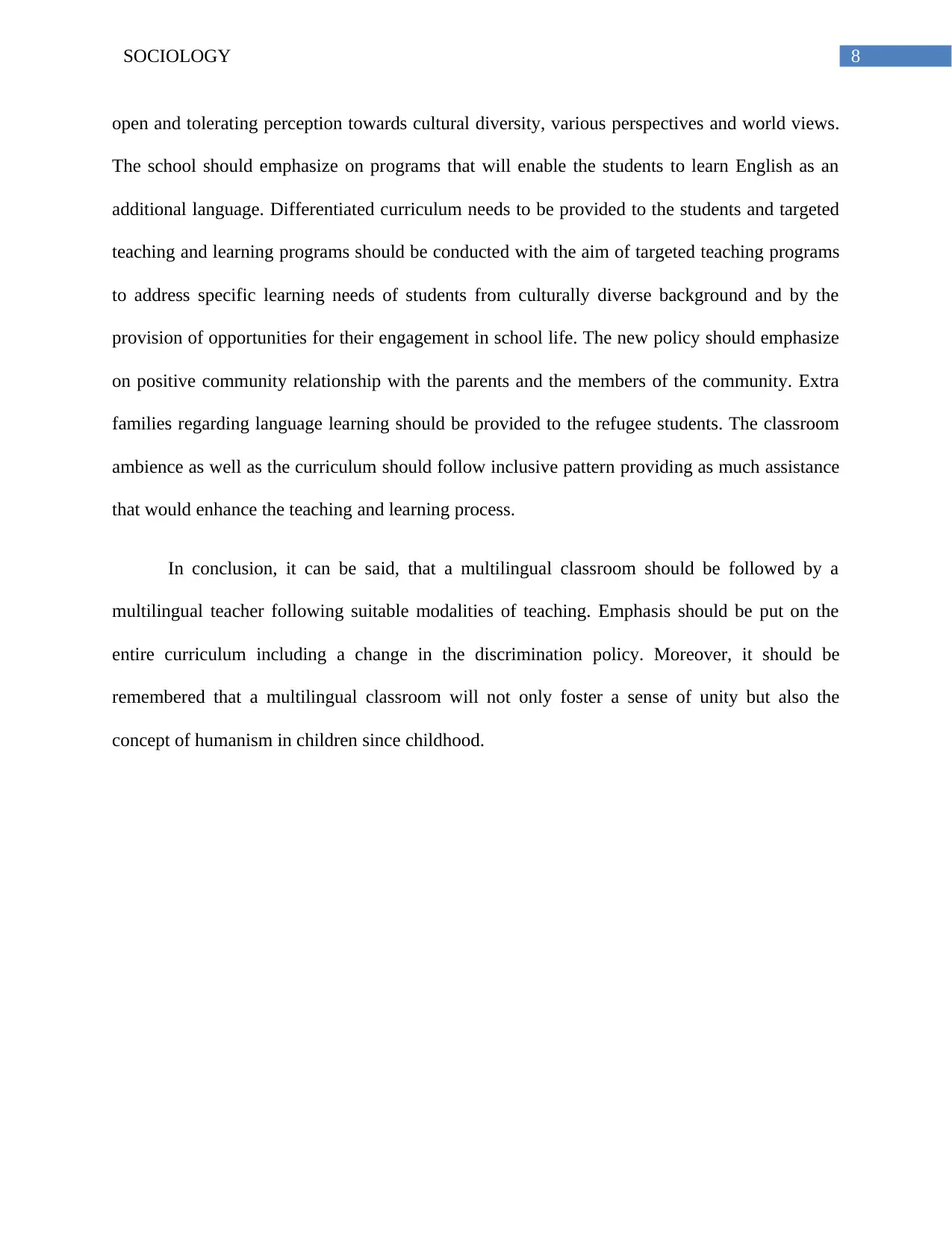
8SOCIOLOGY
open and tolerating perception towards cultural diversity, various perspectives and world views.
The school should emphasize on programs that will enable the students to learn English as an
additional language. Differentiated curriculum needs to be provided to the students and targeted
teaching and learning programs should be conducted with the aim of targeted teaching programs
to address specific learning needs of students from culturally diverse background and by the
provision of opportunities for their engagement in school life. The new policy should emphasize
on positive community relationship with the parents and the members of the community. Extra
families regarding language learning should be provided to the refugee students. The classroom
ambience as well as the curriculum should follow inclusive pattern providing as much assistance
that would enhance the teaching and learning process.
In conclusion, it can be said, that a multilingual classroom should be followed by a
multilingual teacher following suitable modalities of teaching. Emphasis should be put on the
entire curriculum including a change in the discrimination policy. Moreover, it should be
remembered that a multilingual classroom will not only foster a sense of unity but also the
concept of humanism in children since childhood.
open and tolerating perception towards cultural diversity, various perspectives and world views.
The school should emphasize on programs that will enable the students to learn English as an
additional language. Differentiated curriculum needs to be provided to the students and targeted
teaching and learning programs should be conducted with the aim of targeted teaching programs
to address specific learning needs of students from culturally diverse background and by the
provision of opportunities for their engagement in school life. The new policy should emphasize
on positive community relationship with the parents and the members of the community. Extra
families regarding language learning should be provided to the refugee students. The classroom
ambience as well as the curriculum should follow inclusive pattern providing as much assistance
that would enhance the teaching and learning process.
In conclusion, it can be said, that a multilingual classroom should be followed by a
multilingual teacher following suitable modalities of teaching. Emphasis should be put on the
entire curriculum including a change in the discrimination policy. Moreover, it should be
remembered that a multilingual classroom will not only foster a sense of unity but also the
concept of humanism in children since childhood.
⊘ This is a preview!⊘
Do you want full access?
Subscribe today to unlock all pages.

Trusted by 1+ million students worldwide
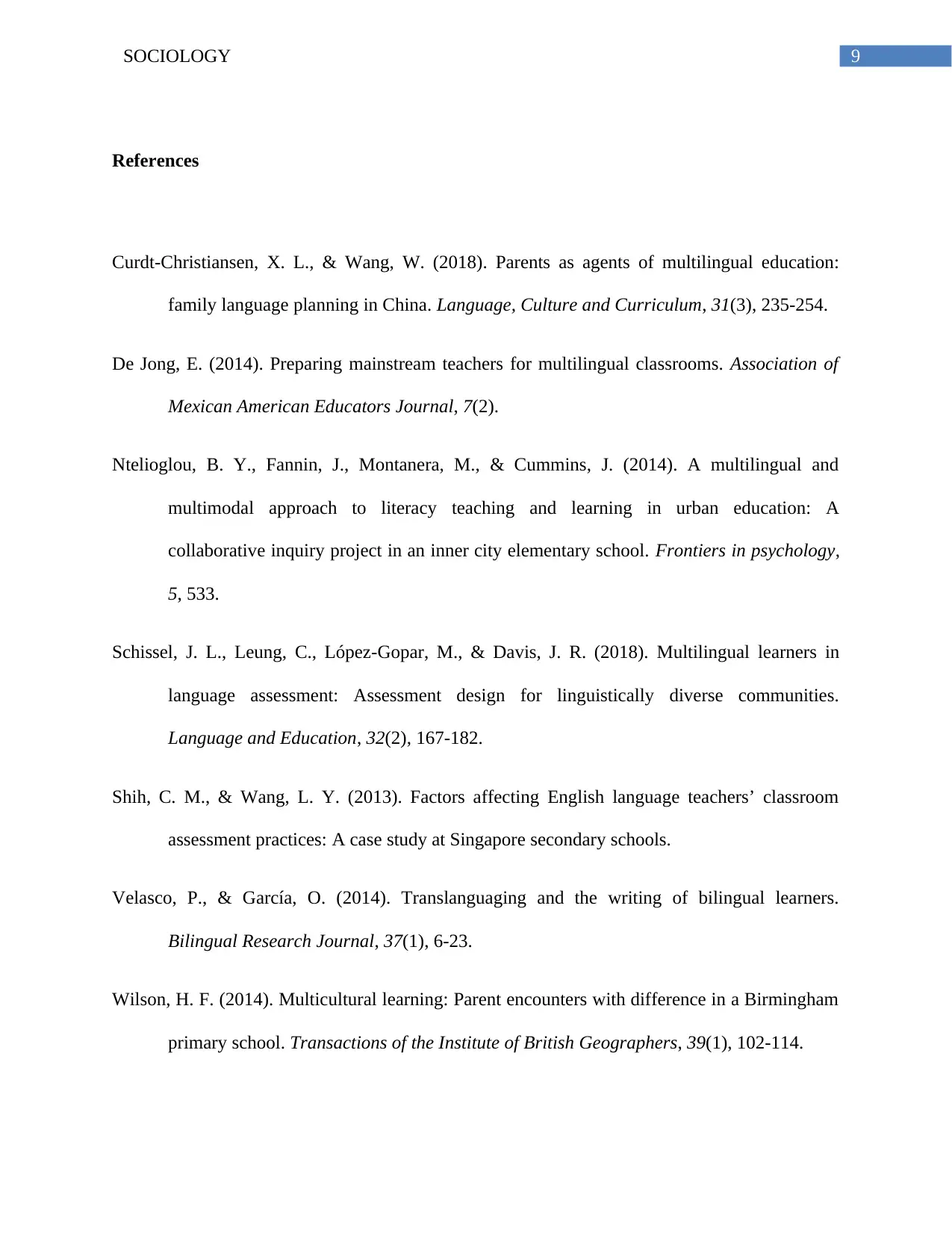
9SOCIOLOGY
References
Curdt-Christiansen, X. L., & Wang, W. (2018). Parents as agents of multilingual education:
family language planning in China. Language, Culture and Curriculum, 31(3), 235-254.
De Jong, E. (2014). Preparing mainstream teachers for multilingual classrooms. Association of
Mexican American Educators Journal, 7(2).
Ntelioglou, B. Y., Fannin, J., Montanera, M., & Cummins, J. (2014). A multilingual and
multimodal approach to literacy teaching and learning in urban education: A
collaborative inquiry project in an inner city elementary school. Frontiers in psychology,
5, 533.
Schissel, J. L., Leung, C., López-Gopar, M., & Davis, J. R. (2018). Multilingual learners in
language assessment: Assessment design for linguistically diverse communities.
Language and Education, 32(2), 167-182.
Shih, C. M., & Wang, L. Y. (2013). Factors affecting English language teachers’ classroom
assessment practices: A case study at Singapore secondary schools.
Velasco, P., & García, O. (2014). Translanguaging and the writing of bilingual learners.
Bilingual Research Journal, 37(1), 6-23.
Wilson, H. F. (2014). Multicultural learning: Parent encounters with difference in a Birmingham
primary school. Transactions of the Institute of British Geographers, 39(1), 102-114.
References
Curdt-Christiansen, X. L., & Wang, W. (2018). Parents as agents of multilingual education:
family language planning in China. Language, Culture and Curriculum, 31(3), 235-254.
De Jong, E. (2014). Preparing mainstream teachers for multilingual classrooms. Association of
Mexican American Educators Journal, 7(2).
Ntelioglou, B. Y., Fannin, J., Montanera, M., & Cummins, J. (2014). A multilingual and
multimodal approach to literacy teaching and learning in urban education: A
collaborative inquiry project in an inner city elementary school. Frontiers in psychology,
5, 533.
Schissel, J. L., Leung, C., López-Gopar, M., & Davis, J. R. (2018). Multilingual learners in
language assessment: Assessment design for linguistically diverse communities.
Language and Education, 32(2), 167-182.
Shih, C. M., & Wang, L. Y. (2013). Factors affecting English language teachers’ classroom
assessment practices: A case study at Singapore secondary schools.
Velasco, P., & García, O. (2014). Translanguaging and the writing of bilingual learners.
Bilingual Research Journal, 37(1), 6-23.
Wilson, H. F. (2014). Multicultural learning: Parent encounters with difference in a Birmingham
primary school. Transactions of the Institute of British Geographers, 39(1), 102-114.
Paraphrase This Document
Need a fresh take? Get an instant paraphrase of this document with our AI Paraphraser
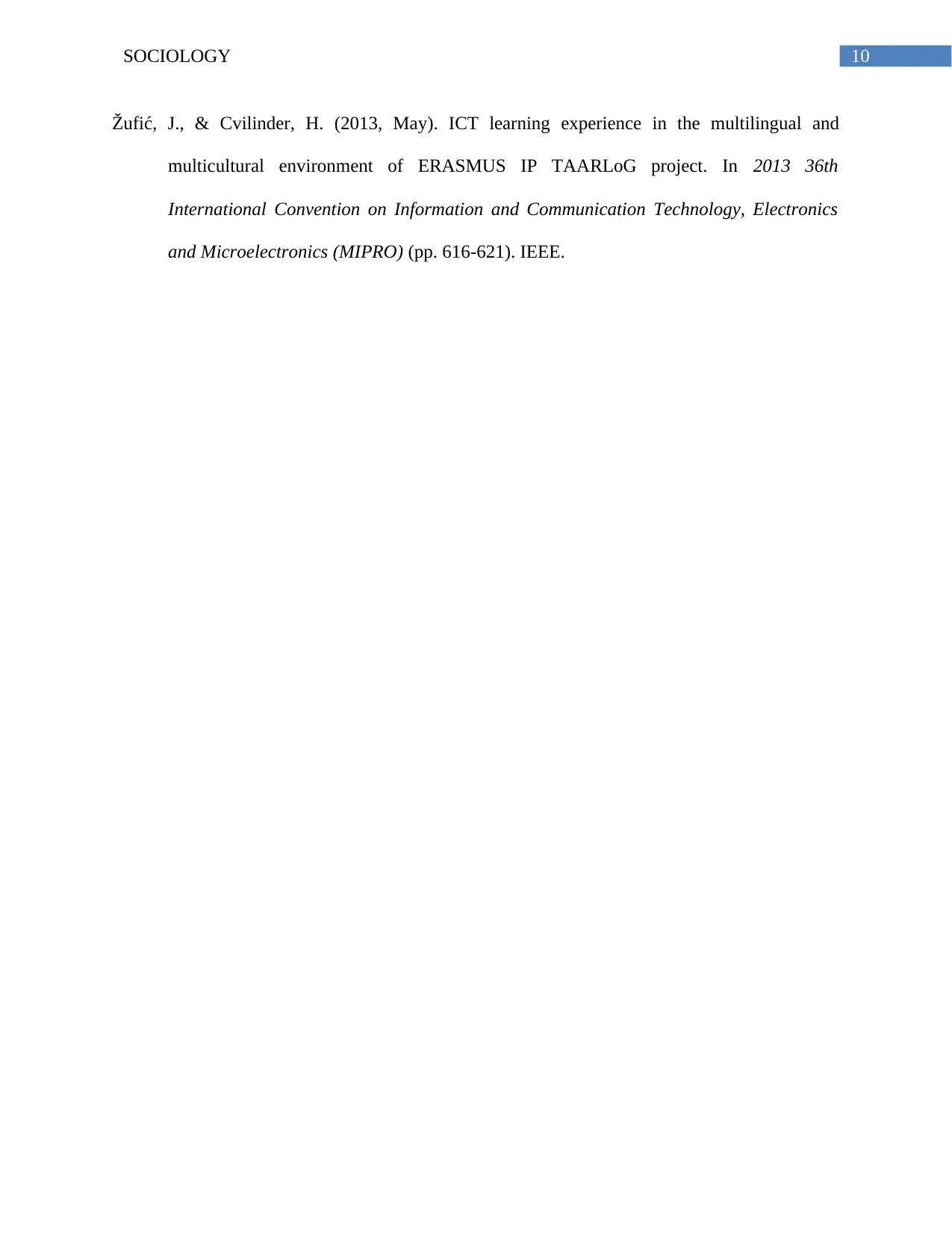
10SOCIOLOGY
Žufić, J., & Cvilinder, H. (2013, May). ICT learning experience in the multilingual and
multicultural environment of ERASMUS IP TAARLoG project. In 2013 36th
International Convention on Information and Communication Technology, Electronics
and Microelectronics (MIPRO) (pp. 616-621). IEEE.
Žufić, J., & Cvilinder, H. (2013, May). ICT learning experience in the multilingual and
multicultural environment of ERASMUS IP TAARLoG project. In 2013 36th
International Convention on Information and Communication Technology, Electronics
and Microelectronics (MIPRO) (pp. 616-621). IEEE.
1 out of 11